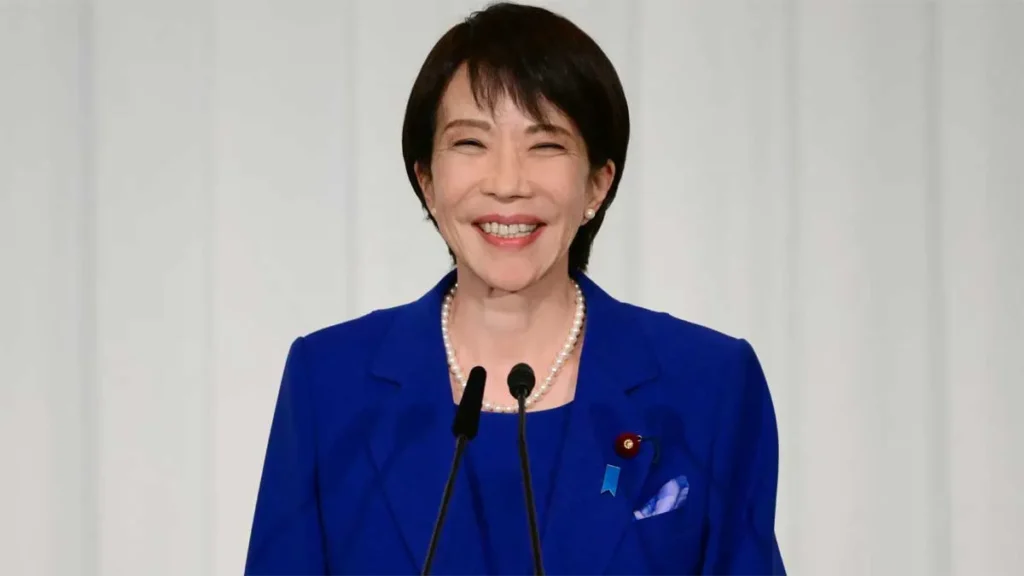New Delhi: In a landmark moment for Japanese politics, Sanae Takaichi has been officially elected as Japan’s first female Prime Minister, shattering decades of male-dominated leadership in the world’s third-largest economy. The ultraconservative politician, often dubbed Japan’s “Iron Lady,” secured victory in a tense parliamentary vote on October 21, 2025, paving the way for a rightward shift in governance amid mounting economic and security pressures.
This historic election not only highlights Takaichi’s personal triumph but also underscores evolving dynamics in Japan’s political landscape. As the nation grapples with inflation, geopolitical tensions, and internal scandals, her ascent raises critical questions: Can she stabilize the government and deliver on her bold vision?

The Parliamentary Vote: A Narrow Win Sealing Historic Destiny
Japan’s National Diet, the country’s bicameral legislature comprising the House of Representatives and the House of Councillors, confirmed Takaichi’s premiership in a decisive yet precarious ballot. She garnered 237 votes in the lower house—barely exceeding the majority threshold—compared to 149 votes for Yoshihiko Noda, leader of the opposition Constitutional Democratic Party of Japan.
The vote marked the end of a chaotic three-month period following the Liberal Democratic Party’s (LDP) stunning defeat in July elections, which eroded its unchallenged dominance. Takaichi steps in to replace Shigeru Ishiba, whose one-year tenure ended with his Cabinet’s resignation earlier that day, creating a brief but symbolic transition.
Upon announcement of the results, Takaichi rose in the chamber and offered a profound bow, a gesture embodying Japanese traditions of humility and resolve. Her path to this moment involved intense last-minute maneuvering: The LDP forged a fresh coalition with the Osaka-based Japan Innovation Party (JIP, or Ishin no Kai), a right-wing outfit led by figures like Osaka Governor Hirofumi Yoshimura. This pact, signed on October 20, 2025, emphasized hawkish policies on security and nationalism, ensuring just enough legislative seats for her confirmation.
Notably, JIP has opted against immediate Cabinet positions, signaling caution in the unproven alliance. “Political stability is essential right now,” Takaichi declared at the signing ceremony. “Without stability, we cannot push measures for a strong economy or diplomacy.” Yet, this minority government falls short of majorities in both parliamentary houses, forcing Takaichi to woo splinter opposition factions for every bill—a recipe for potential gridlock.
From Humble Roots to LDP Powerhouse: Takaichi’s Personal Journey
At 64, Sanae Takaichi brings a rags-to-power narrative uncommon among Japan’s elite politicians. Born in Nara Prefecture in central Japan, she graduated from Kobe University—a solid but non-ivy institution compared to the University of Tokyo or overseas pedigrees like Harvard favored by many LDP veterans.
Takaichi entered the political fray in the early 1990s, securing her first parliamentary seat in 1993 under the LDP banner. Her ascent accelerated as protégé to the late Shinzo Abe, Japan’s longest-serving Prime Minister until his 2022 assassination. She held key roles across Abe’s Cabinets and continued under Fumio Kishida, including stints as Minister of Economic Security and Minister of Internal Affairs.
Unlike many peers from aristocratic political dynasties, Takaichi’s background reflects grassroots tenacity. This “everywoman” appeal, combined with unyielding loyalty to LDP traditions, positioned her as a unifying conservative force during the party’s recent leadership turmoil.
Ideological Core: Thatcher-Inspired Conservatism with a Japanese Twist
Takaichi’s worldview draws direct inspiration from Margaret Thatcher, earning her the “Iron Lady” moniker in domestic media. Yet, her conservatism diverges from Western models, blending nationalism, security hawkishness, and robust social welfare—hallmarks of Japan’s unique right-wing tradition.
Economically, she champions a revival of “Abenomics”: aggressive fiscal spending, central bank monetary stimulus, and market liberalization to combat stagnation. Socially, she remains steadfastly traditionalist—opposing same-sex marriage, advocating male-preference in imperial succession, and resisting separate surnames for married couples. On immigration, her stance is restrictive, prioritizing national cohesion over influxes of foreign labor.
Foreign policy defines her edge: A vocal “China hawk,” Takaichi pushes for military expansion, unwavering support for the U.S.-Japan alliance, and preservation of the Taiwan Strait status quo. She has repeatedly visited Taipei to engage Taiwan’s parties, infuriating Beijing. Her visits to Yasukuni Shrine—a controversial memorial honoring Japan’s war dead, including WWII criminals—have sparked outrage in China and South Korea, who view them as unrepentant glorification of imperialism.
Recently, Takaichi has moderated her tone: On October 17, 2025, she dispatched a religious offering to Yasukuni instead of attending personally, a pragmatic nod to coalition-building. Experts like Stephen Nagy, professor at International Christian University, describe Japanese conservatism as “strong on security, tough on China, devoted to the emperor system, and committed to interventionist welfare.” Under Takaichi, expect continuity in defense buildup and U.S. ties, but no dismantling of Japan’s generous safety nets.
Coalition Chaos: From Komeito Split to JIP Lifeline
Takaichi’s victory emerged from the ashes of LDP misfortunes. The party’s longtime ally, the centrist Komeito—rooted in Buddhist pacifism—abruptly exited the coalition post her LDP leadership win in October. Disagreements over slush-fund corruption scandals, which triggered consecutive electoral losses, proved the breaking point.
Komeito also bristled at Takaichi’s historical revisionism and Yasukuni devotion, seeing them as barriers to remorseful diplomacy with Asia. This fracture nearly handed power to the fragmented opposition, but the LDP’s pivot to JIP salvaged the day. The new partners align on nationalism but must navigate JIP’s regional Osaka focus and anticorruption zeal.
Takaichi’s incoming Cabinet will feature heavyweights like Taro Aso, the LDP’s influential elder statesman and key backer. Her first acts include a major policy address this week, urgent talks with U.S. President Donald Trump, and regional summits—all while racing to unveil anti-inflation measures by December.
Pressing Challenges: Economy, Scandals, and Global Storms
Takaichi inherits a perfect storm. Japan’s cost-of-living crisis—fueled by global energy shocks and a weakening yen—has eroded public trust. The LDP’s corruption woes, involving undisclosed campaign funds, linger as a toxic legacy. Geopolitically, North Korean missile tests, Chinese assertiveness, and Trump’s trade aggressions demand deft navigation.
Domestically, her lukewarm stance on gender equality draws scrutiny. Despite her trailblazing role, Takaichi has blocked women’s advancement bills, prioritizing tradition over quotas or diversity mandates. Analysts warn her “tough edges” must soften to avoid a no-confidence vote; her government’s minority status amplifies every misstep.
As Japan’s fourth Prime Minister in five years, Takaichi’s tenure tests the LDP’s resilience. Success could cement a conservative renaissance; failure risks upending post-war political order.
Japan-India Parallels: Shared Democratic Foundations Amid Leadership Milestones
Takaichi’s rise invites comparisons to global peers, including India’s robust parliamentary system. Both nations uphold written constitutions—India’s the world’s longest, Japan’s concise at under 5,000 words. As fellow parliamentary democracies, they vest executive power in elected Prime Ministers, supported by bicameral legislatures: Japan’s National Diet (House of Representatives and House of Councillors) mirrors India’s Parliament (Lok Sabha and Rajya Sabha).
Core similarities extend to Chapter III of Japan’s Constitution (Articles 10–40), safeguarding equality, liberty, and dignity, akin to India’s Part III (Articles 12–35) enumerating six fundamental rights. Independent judiciaries, universal adult suffrage, and constitutional supremacy bind these Asian giants. Takaichi’s election echoes India’s trailblazers, signaling incremental inclusivity without upending systemic traditions.
What Lies Ahead for Japan’s Iron Lady?
Sanae Takaichi’s premiership begins with ceremonial formality: a meeting with Emperor Naruhito on October 22, 2025, formalizing her mandate. Yet, history’s first female PM faces skepticism over her limited diplomatic resume and coalition fragility.
Optimists see her Abe-like resolve reviving Japan’s mojo; pessimists predict a short, stormy reign. As she balances hawkish instincts with pragmatic governance, the world watches: Will Japan’s “Iron Lady” forge enduring steel, or bend under pressure?
FAQs
1. Who is Sanae Takaichi, and what is her political background?
Sanae Takaichi, aged 64, is a longtime Liberal Democratic Party (LDP) member who entered parliament in 1993. Born in Nara Prefecture, she graduated from Kobe University and rose as a protégé of the late Prime Minister Shinzo Abe, serving in key roles like Minister of Economic Security and Internal Affairs under Abe and Fumio Kishida. Known as Japan’s “Iron Lady” for her admiration of Margaret Thatcher, she brings a humble, non-elite background to leadership.
2. How did Sanae Takaichi win the prime minister election?
On October 21, 2025, Japan’s National Diet elected Takaichi with 237 votes in the lower house, surpassing the majority needed. After the LDP lost its majority in July elections and split from ally Komeito over corruption scandals, she secured victory through a last-minute coalition with the right-wing Japan Innovation Party (JIP). This replaced Shigeru Ishiba, ending a three-month political vacuum.
3. What are Sanae Takaichi’s key policies and ideological views?
Takaichi advocates reviving “Abenomics” for economic growth via fiscal expansion, monetary easing, and reforms. She is socially conservative—opposing same-sex marriage, favoring male imperial succession, and limiting immigration—while pushing military strengthening, strong U.S. ties, and a firm stance against China (including Taiwan support). Her Yasukuni Shrine visits highlight nationalist leanings, though she recently moderated by sending offerings instead.
4. What challenges does Prime Minister Takaichi face?
Her minority government lacks majorities in both parliamentary houses, requiring opposition support for legislation and risking instability. Key issues include Japan’s cost-of-living crisis, LDP corruption recovery, U.S. trade tensions under President Trump, and threats from China and North Korea. Experts urge her to temper hawkish views to avoid a no-confidence vote.
5. How does Japan’s political system compare to India’s, and what makes Takaichi’s election historic?
Both are parliamentary democracies with bicameral legislatures (Japan’s National Diet vs. India’s Parliament), written constitutions, fundamental rights protections, independent judiciaries, and universal suffrage. Takaichi’s win marks her as Japan’s first female Prime Minister, symbolizing gradual gender inclusivity while maintaining conservative traditions.

